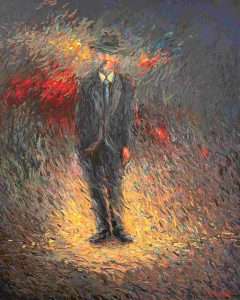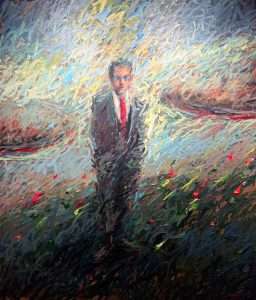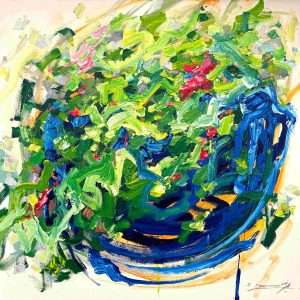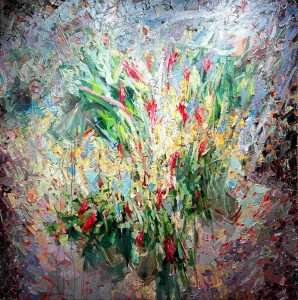As mentioned, Assanloo has been a disciple of Katouzian and possesses a deep understanding of realistic painting; by observing his works and the process of changes in Assanloo’s style, it can be understood that he initiated with social realism and gradually moved towards surrealism and expressionism, ultimately leaning towards abstraction.
He accomplishes this with more blur and ambiguity in figures and portraits. The style of these works is expressionist, and the artist applies it through vigorous and powerful strokes, as well as numerous layers, at times using finger strokes. The expressiveness in execution indicates the painter’s power in design. Assanloo’s paintings and sculptures reveal a mental atmosphere, displaying the portrayal of human psychological states and issues in a realistic space. This characteristic is the essence of Alireza Assanloo’s art, and the artist has managed to use his brush to capture a moment of human existence amidst a multitude of sorrows, loneliness, pain, and a silence where only colors scream.
Humans are at the center of Assanloo’s works, both in form and content. This centrality is observable in his paintings that delve into social themes and contemporary human life. He believes that the world is undergoing a transformation into a space entirely different from what we know. Therefore, Assanloo’s paintings and sculptures reflect this sense of becoming rather than being.
The use of color is prominent in conveying emotional depth within the figures. The paintings often feature dark backgrounds, drawing attention to the figures or portraits. The direction and focus of the facial expressions further emphasize this centrality.
Details in portraits and figures play a significant role in conveying the artistic message. Assanloo hides an abundance of bright color spots within these details to create a holistic message about the human experience.
The title “Didaar Be Qiyamat” (Meeting with Resurrection) is inspired by famous sentences from Sadegh Hedayat. Assanloo interprets Hedayat’s world through a cognitive beauty approach, blending realism, abstraction, and authenticity. The exhibition explores Hedayat’s worldview, encapsulating the essence of a person who lived rapidly, extracted his works from the masses, and left the stage.
Regarding the accusation that Hedayat is often perceived as a narrator of despair, Assanloo defends the notion that Hedayat, in the guise of a storyteller, concealed his true self within layers of life’s realities. Life’s essential themes and the highest persona are central to Hedayat’s works, transcending the portrayal of beautiful anatomical details, aiming to guide the viewer toward recognizing the profound content of life.
Assanloo believes that the necessity to explore Hedayat’s atmosphere led him to use the theme of Hedayat’s works in his paintings. He emphasizes that he is indifferent to the content’s subjects beyond his knowledge in terms of their themes. Instead, he views painting in Hedayat’s atmosphere as a necessity, not just an interesting choice. The “Didaar” collection delves into another aspect, resembling faces claimed to be Sadegh Hedayat, inviting the viewer to a continuous journey between the realms of imagination and reality.
In the exhibition, portraits of Sadegh Hedayat are depicted with imaginative feelings, and the artist creates them without external references. The goal is to engage the viewer in a continuous and harmonious journey between the realms of imagination and reality, enabling them to discover symbolic meanings of the subject.
The critic Sohrab Ahmadi, in various parts of the exhibition description, notes that “Didaar Be Qiyamat” transforms faces from clear and distinct expressions to a blurred and disrupted network of meanings, leading the viewer to a world of the unknown and intriguing. The fragmentation of facial expressions and the decentering of the facial element redefine the face, presenting a fresh perspective on the unknown and confronting a world beyond the familiar.
Works available in Zarin Gallery:
200*160 cm
Acrylic on canvas
170*200 cm
Acrylic on canvas
130*130 cm
Acrylic on canvas
200*200 cm
Acrylic on canvas



 فارسی
فارسی


